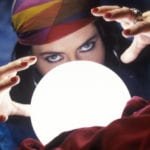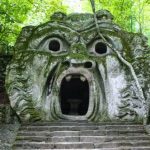 Weird Stuff
Weird Stuff  Weird Stuff
Weird Stuff  Our World
Our World 10 Ways Your Christmas Tree Is More Lit Than You Think
 Movies and TV
Movies and TV The 10 Coolest Stars to Set Sail on The Love Boat
 History
History 10 Things You Didn’t Know About the American National Anthem
 Technology
Technology Top 10 Everyday Tech Buzzwords That Hide a Darker Past
 Humans
Humans 10 Everyday Human Behaviors That Are Actually Survival Instincts
 Animals
Animals 10 Animals That Humiliated and Harmed Historical Leaders
 History
History 10 Most Influential Protests in Modern History
 Creepy
Creepy 10 More Representations of Death from Myth, Legend, and Folktale
 Technology
Technology 10 Scientific Breakthroughs of 2025 That’ll Change Everything
 Weird Stuff
Weird Stuff Ten Bizarre Facts About The Doge Meme
 Our World
Our World 10 Ways Your Christmas Tree Is More Lit Than You Think
 Movies and TV
Movies and TV The 10 Coolest Stars to Set Sail on The Love Boat
Who's Behind Listverse?

Jamie Frater
Head Editor
Jamie founded Listverse due to an insatiable desire to share fascinating, obscure, and bizarre facts. He has been a guest speaker on numerous national radio and television stations and is a five time published author.
More About Us History
History 10 Things You Didn’t Know About the American National Anthem
 Technology
Technology Top 10 Everyday Tech Buzzwords That Hide a Darker Past
 Humans
Humans 10 Everyday Human Behaviors That Are Actually Survival Instincts
 Animals
Animals 10 Animals That Humiliated and Harmed Historical Leaders
 History
History 10 Most Influential Protests in Modern History
 Creepy
Creepy 10 More Representations of Death from Myth, Legend, and Folktale
 Technology
Technology 10 Scientific Breakthroughs of 2025 That’ll Change Everything
10 Movie Monsters Who Went from Scary to Silly
A good horror film usually sports a good horror villain. Sure enough, cinema has given us plenty of greats. Ranging from supernatural enigmas to scientific anomalies, these intimidating icons strike terror into audiences’ hearts the world over. Not all of them stay that way, though.
Many movie monsters change their image as their series go on, becoming less frightening and more farcical. This move often results from filmmakers’ desperation. Fresh out of ideas, they throw everything at the wall to see what sticks. Other times, it could be intentional, signifying a new direction for the franchise. This different approach might be fitting; it varies with the creature. Whatever the reason, it doesn’t change the fact that these horror icons go from scary to silly.
Related: 10 Oldest Monster Myths
10 Freddy Krueger
To be fair, Freddy Krueger always played with his food. A Nightmare on Elm Street positioned this kiddie killer as a nightmarish dream demon. He terrorized the teens of an Ohio suburb while they slept. His methods usually involved planting horrific visions in their minds before executing them in a bloody fashion. He took perverse pleasure in his deviant behavior, particularly when it came to the female leads. That pleasure soon extended to the whole franchise.
A Nightmare on Elm Street became one of those long-running horror series with no end in sight. Each entry got steadily sillier, putting its iconic killer in evermore random scenarios. He even went toe-to-toe with fellow psycho Jason Voorhees at one point. Freddy goes along with all these twists with the same mischievous schtick as his other exploits. He doesn’t take any of it seriously, so why should fans?[1]
9 Godzilla
He may have a reputation for monster mashes nowadays, but Godzilla originated as an atomic allegory. His 1954 debut is an ominous cautionary tale about nuclear destruction. Awoken by hydrogen bombs, Godzilla (or Gojira) was a colossal creature who destroyed two Japanese cities, leaving irradiated ruins in his wake. The result was a grim reminder of the atomic bombs dropped on Japan in World War II. Such uncomfortable themes were not to last.
The following films got progressively cheesier. They became less about worldly messages and more about explosive kaiju clashes. Godzilla himself adopted quirkier qualities to match that shift. One minute, he might laugh at his fellow monster’s misfortune. The next minute, he could break out in a flamboyant victory dance. He was no longer a multi-story force of nuclear holocaust. Instead, he was a goofy guardian who protected the planet from nastier baddies. At least he found a new, corny appeal in the process.[2]
8 The Deadites
This turn was emblematic of the series’ shift in tone. The original Evil Dead was a straight-faced horror flick. A group of kids inadvertently summoned a legion of demons to their cabin retreat. The monsters then possessed and tormented the unsuspecting victims, taking sadistic pleasure in their gruesome deaths. Their macabre mockery caused the heroes to break down in despair, and the audience was right there with them. Soon, though, the villains were more mocking than macabre.
As the franchise went on, these “Deadites” devolved from hellish demons to cheesy pranksters. Sure, they still killed plenty of people, but their main goal was one-upping the comically macho hero, Ash Williams. By the time Army of Darkness and Ash vs. Evil Dead rolled around, they’d resorted to zany slapstick straight out of a Three Stooges sketch. Thankfully, that change complemented Ash’s wealth of one-liners, giving the series a much stronger identity as a result.[3]
7 The Terminator
Machines are rarely funny. The Terminator certainly wasn’t, at least initially. The 1984 sci-fi classic was a chaotic chase where a futuristic cyborg came back in time to assassinate the mother of its enemy. Though human in appearance, it was literally a killing machine—ruthless in its pursuit and emotionless in its execution. Those perks made for a tense thriller, which never let up for a second. Once the characters reprogrammed the robot, though, problems arose.
Subsequent Terminator films positioned the original model as a protector. In addition to defending the heroes from his cyborg brethren, he tried assimilating into human society. These attempts led to cringe-worthy comedy involving one-liners, awkward smiles, and drapes. The cybernetic killer soon became a stone-faced teddy bear. That journey sadly matched the dumb direction of the series.[4]
6 Chucky
Chucky took cues from Freddie Krueger in teasing his victims. However, he was still a serial killer trapped in a doll’s body, so his pent-up rage came out in a slew of gruesome kills across the Child’s Play series. These mean-spirited scenes tried to compensate for the character’s miniature size and cartoonish appearance. Eventually, though, they just stopped trying.
Both Chucky and the franchise embraced the inherent silliness. He had far more fun with his wacky executions, letting off a maniacal laugh and a one-liner every time he racked up a body. Speaking of bodies, he began using his old voodoo magic on a whim. The combinations were truly bizarre. Not only did he gain a wife and child, but he transferred his consciousness to a disabled woman to torture a new generation of kids. As goofy as it was, the tone finally matched the mascot.[5]
5 The Leprechaun
It’s hard to make a leprechaun scary, but these movies gave it a good try. The aptly titled Leprechaun film revolved around the eponymous Irish icon, who hunted down anyone suspected of stealing his gold. His supernatural roots made him impervious to most damage, so the characters had no choice but to run. It’s a predictable setup, which the movie used for conventional slasher scares. On the other hand, the following films were anything but conventional.
The Leprechaun series got even weirder than its horror peers. Sequels plopped the perky murderer into all sorts of strange settings. Locales ranged from Las Vegas to deep space to “the hood.” He met all these scenarios with the same sadistic glee. At a certain point, the appeal came from picking a bizarre playground and letting him run amok. Much like Child’s Play, though, this approach signaled the creators were now in on the joke.[6]
4 The Predator
Intelligent alien life is an ominous concept. The Predator lived up to that frightening mystery in the 1988 film. This extraterrestrial hunter distinguished itself by taking out an elite team of soldiers. All their training meant nothing when they were skinned alive. The idea of something with superior skills, advanced weaponry, and a penchant for killing was enough to drain anyone’s courage, even if one of the soldiers was played by Arnold Schwarzenegger. The creature itself seemed to take the wrong lesson from its quarry.
Namely, the Predator became a cheesy action star of sorts. The sequel tackled various gangs in a dystopian (yet sadly authentic) version of Los Angeles while bringing back a funny one-liner from the first flick. Then came the maligned Alien vs. Predator movies, which cheapened both monsters through ludicrous writing and bombastic nonsense. True, later entries like Predators and Prey restored some dignity to the hunter, but the damage was done.[7]
3 Pinhead
At first glance, the Hellraiser villain was consistently serious. This British soldier lost his humanity during World War I, leading him to become a Satanic priest. His position gave him power over the Cenobites: humans morphed into sadomasochistic demons. The mere sight was enough to repulse audiences. Their leader, in particular, was a grotesque individual with his pale skin and nail-covered head. Sadly, that picture also led to a mocking moniker.
Fans took to calling him “Pinhead.” This goofy title immediately nixed any fear associated with the hellish priest. He didn’t do much to mitigate that, either. His prim and proper demeanor was initially akin to Dracula, but it eventually came off as an aristocratic archetype, which comically clashed with the chaos around him. Couple that with his insane schemes in later films, and you had a villain consistently undermined by everything around him.[8]
2 Hannibal Lecter
How ironic that the defining depiction became the worst. Although it wasn’t his first appearance, The Silence of the Lambs earned widespread attention for its incarcerated killer. Hannibal Lecter was a sociopathic psychiatrist who killed several people and used their bodies in his recipes. This method betrayed a narcissistic theatricality, which Anthony Hopkins used to instill aristocratic fear. He might have been locked up, but his methodical mind still made him dangerous beyond his meager screen time.
The following films—Hannibal and Red Dragon—afforded more exposure to the mad doctor. The unfortunate side effect was that his playful brilliance became downright stupid. He began killing people in needlessly elaborate ways after obscene amounts of teasing. This routine made him less of an imposing cannibal and more of a discount Bond villain. Hopkins didn’t help matters by hamming up his performance. In the end, Lecter diminished his menace by indulging too much in his own image.[9]
1 Dracula
Arguably the most famous movie monster of all time, Dracula was an enigmatic vampire who terrorized Victorian London in an unholy crusade for blood and love. That’s the case in Bram Stoker’s novel, and it’s been roughly the same in the numerous adaptations. Every generation has had at least one version of the Prince of Darkness. Many of them have reveled in gothic horror, striking primal fear into audiences through the villain’s mix of smooth class, lethal cunning, and bestial hunger. In fact, he’s sometimes been too popular for his own good.
The vampire’s reputation cheapened his impact. To begin with, the successful Dracula depictions called for sequels. These additions came up with increasingly contrived ways to resurrect him and even more ridiculous ways to put him down. Not to mention, the explosion of vampire media robbed Dracula of his novelty, especially given the attempts to modernize and/or lampoon the concept. These aspects made the count a cheesy cliché in many viewers’ eyes. Now, many see him as more of a meme than a character.[10]








